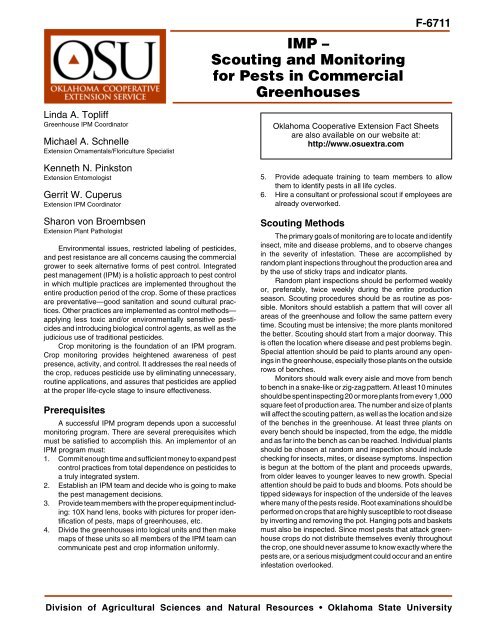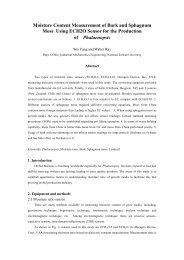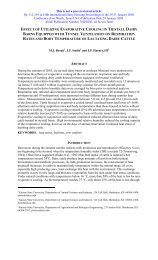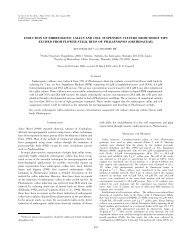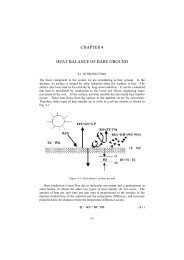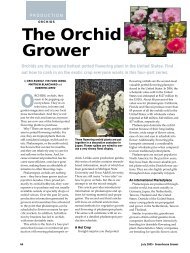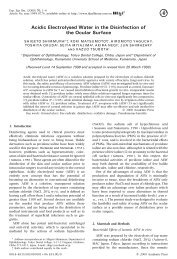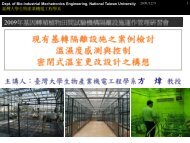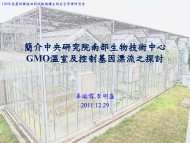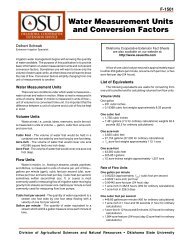IMP – Scouting and Monitoring for Pests in Commercial Greenhouses
IMP – Scouting and Monitoring for Pests in Commercial Greenhouses
IMP – Scouting and Monitoring for Pests in Commercial Greenhouses
You also want an ePaper? Increase the reach of your titles
YUMPU automatically turns print PDFs into web optimized ePapers that Google loves.
<strong>IMP</strong> <strong>–</strong><strong>Scout<strong>in</strong>g</strong> <strong>and</strong> <strong>Monitor<strong>in</strong>g</strong><strong>for</strong> <strong>Pests</strong> <strong>in</strong> <strong>Commercial</strong><strong>Greenhouses</strong>F-6711L<strong>in</strong>da A. TopliffGreenhouse IPM Coord<strong>in</strong>atorMichael A. SchnelleExtension Ornamentals/Floriculture SpecialistKenneth N. P<strong>in</strong>kstonExtension EntomologistGerrit W. CuperusExtension IPM Coord<strong>in</strong>atorSharon von BroembsenExtension Plant PathologistEnvironmental issues, restricted label<strong>in</strong>g of pesticides,<strong>and</strong> pest resistance are all concerns caus<strong>in</strong>g the commercialgrower to seek alternative <strong>for</strong>ms of pest control. Integratedpest management (IPM) is a holistic approach to pest control<strong>in</strong> which multiple practices are implemented throughout theentire production period of the crop. Some of these practicesare preventative—good sanitation <strong>and</strong> sound cultural practices.Other practices are implemented as control methods—apply<strong>in</strong>g less toxic <strong>and</strong>/or environmentally sensitive pesticides<strong>and</strong> <strong>in</strong>troduc<strong>in</strong>g biological control agents, as well as thejudicious use of traditional pesticides.Crop monitor<strong>in</strong>g is the foundation of an IPM program.Crop monitor<strong>in</strong>g provides heightened awareness of pestpresence, activity, <strong>and</strong> control. It addresses the real needs ofthe crop, reduces pesticide use by elim<strong>in</strong>at<strong>in</strong>g unnecessary,rout<strong>in</strong>e applications, <strong>and</strong> assures that pesticides are appliedat the proper life-cycle stage to <strong>in</strong>sure effectiveness.PrerequisitesA successful IPM program depends upon a successfulmonitor<strong>in</strong>g program. There are several prerequisites whichmust be satisfied to accomplish this. An implementor of anIPM program must:1. Commit enough time <strong>and</strong> sufficient money to exp<strong>and</strong> pestcontrol practices from total dependence on pesticides toa truly <strong>in</strong>tegrated system.2. Establish an IPM team <strong>and</strong> decide who is go<strong>in</strong>g to makethe pest management decisions.3. Provide team members with the proper equipment <strong>in</strong>clud<strong>in</strong>g:10X h<strong>and</strong> lens, books with pictures <strong>for</strong> proper identificationof pests, maps of greenhouses, etc.4. Divide the greenhouses <strong>in</strong>to logical units <strong>and</strong> then makemaps of these units so all members of the IPM team cancommunicate pest <strong>and</strong> crop <strong>in</strong><strong>for</strong>mation uni<strong>for</strong>mly.Oklahoma Cooperative Extension Fact Sheetsare also available on our website at:http://www.osuextra.com5. Provide adequate tra<strong>in</strong><strong>in</strong>g to team members to allowthem to identify pests <strong>in</strong> all life cycles.6. Hire a consultant or professional scout if employees arealready overworked.<strong>Scout<strong>in</strong>g</strong> MethodsThe primary goals of monitor<strong>in</strong>g are to locate <strong>and</strong> identify<strong>in</strong>sect, mite <strong>and</strong> disease problems, <strong>and</strong> to observe changes<strong>in</strong> the severity of <strong>in</strong>festation. These are accomplished byr<strong>and</strong>om plant <strong>in</strong>spections throughout the production area <strong>and</strong>by the use of sticky traps <strong>and</strong> <strong>in</strong>dicator plants.R<strong>and</strong>om plant <strong>in</strong>spections should be per<strong>for</strong>med weeklyor, preferably, twice weekly dur<strong>in</strong>g the entire productionseason. <strong>Scout<strong>in</strong>g</strong> procedures should be as rout<strong>in</strong>e as possible.Monitors should establish a pattern that will cover allareas of the greenhouse <strong>and</strong> follow the same pattern everytime. <strong>Scout<strong>in</strong>g</strong> must be <strong>in</strong>tensive; the more plants monitoredthe better. <strong>Scout<strong>in</strong>g</strong> should start from a major doorway. Thisis often the location where disease <strong>and</strong> pest problems beg<strong>in</strong>.Special attention should be paid to plants around any open<strong>in</strong>gs<strong>in</strong> the greenhouse, especially those plants on the outsiderows of benches.Monitors should walk every aisle <strong>and</strong> move from benchto bench <strong>in</strong> a snake-like or zig-zag pattern. At least 10 m<strong>in</strong>utesshould be spent <strong>in</strong>spect<strong>in</strong>g 20 or more plants from every 1,000square feet of production area. The number <strong>and</strong> size of plantswill affect the scout<strong>in</strong>g pattern, as well as the location <strong>and</strong> sizeof the benches <strong>in</strong> the greenhouse. At least three plants onevery bench should be <strong>in</strong>spected, from the edge, the middle<strong>and</strong> as far <strong>in</strong>to the bench as can be reached. Individual plantsshould be chosen at r<strong>and</strong>om <strong>and</strong> <strong>in</strong>spection should <strong>in</strong>cludecheck<strong>in</strong>g <strong>for</strong> <strong>in</strong>sects, mites, or disease symptoms. Inspectionis begun at the bottom of the plant <strong>and</strong> proceeds upwards,from older leaves to younger leaves to new growth. Specialattention should be paid to buds <strong>and</strong> blooms. Pots should betipped sideways <strong>for</strong> <strong>in</strong>spection of the underside of the leaveswhere many of the pests reside. Root exam<strong>in</strong>ations should beper<strong>for</strong>med on crops that are highly susceptible to root diseaseby <strong>in</strong>vert<strong>in</strong>g <strong>and</strong> remov<strong>in</strong>g the pot. Hang<strong>in</strong>g pots <strong>and</strong> basketsmust also be <strong>in</strong>spected. S<strong>in</strong>ce most pests that attack greenhousecrops do not distribute themselves evenly throughoutthe crop, one should never assume to know exactly where thepests are, or a serious misjudgment could occur <strong>and</strong> an entire<strong>in</strong>festation overlooked.Division of Agricultural Sciences <strong>and</strong> Natural Resources • Oklahoma State University
In addition to r<strong>and</strong>om plant monitor<strong>in</strong>g, a daily <strong>in</strong>spectionof <strong>in</strong>dicator plants <strong>and</strong> sticky traps is necessary. The firstdiseased or pest-<strong>in</strong>fested plant found on a bench becomes an<strong>in</strong>dicator plant. This plant is marked with a stake or <strong>in</strong> somemanner that allows the employee to check the same plantdaily. Check<strong>in</strong>g the same plant daily allows <strong>for</strong> an ongo<strong>in</strong>gclose exam<strong>in</strong>ation of pest populations or symptoms as theyspread to surround<strong>in</strong>g plants. The scout can also follow thedevelopment of a pest problem, not<strong>in</strong>g the rate at which the lifecycle is progress<strong>in</strong>g. Track<strong>in</strong>g the development rate providesthe manager with necessary <strong>in</strong><strong>for</strong>mation regard<strong>in</strong>g the besttime <strong>for</strong> pest control measures, if necessary. Indicator plantscan also be used to check if treatments were effective. Ahighly susceptible host plant is an excellent <strong>in</strong>dicator plant.Grown among the commercial crop, it is the first plant tobecome <strong>in</strong>fested or diseased <strong>and</strong> helps simplify crop monitor<strong>in</strong>g.Some highly susceptible host plants <strong>and</strong> the pests theyattract are as follows:1. Whiteflies—tomatoes, lantana, gerbera daisies, <strong>and</strong>fuschias.2. Spider mites—marigolds, roses, <strong>and</strong> parlor palms.3. Aphids—sweet peppers <strong>and</strong> fuschias.4. Thrips—petunias <strong>and</strong> glox<strong>in</strong>ias.5. Tomato Spotted Wilt Virus—petunias <strong>and</strong> glax<strong>in</strong>ias.While <strong>in</strong>dicator plants are useful as monitor<strong>in</strong>g devices, caremust be taken so that they do not become sources ofre<strong>in</strong>festation.Another method of monitor<strong>in</strong>g a greenhouse <strong>for</strong> <strong>in</strong>sectpests is the use of sticky traps. The traps come <strong>in</strong> two colors,a bright yellow <strong>and</strong> a medium blue. Most greenhouses use theyellow traps which attract fly<strong>in</strong>g aphids, fungus gnats, whiteflies,leafm<strong>in</strong>ers, thrips, <strong>and</strong> others. Blue sticky traps are usedto attract ma<strong>in</strong>ly thrips. These brightly colored cards arecovered with a sticky substance that traps the <strong>in</strong>sects. Thesemay be purchased pre-made or materials may be purchasedseparately <strong>and</strong> the traps made by h<strong>and</strong>, which is moreeconomical. When us<strong>in</strong>g only one color, yellow traps shouldbe chosen because of their general attractiveness.Sticky traps should be placed throughout the greenhouse.They should be placed <strong>in</strong> a grid-like fashion, at leastone card per 1,000 square feet of production area. More trapsper square foot of production area are beneficial. They areplaced just above the plant canopy to 16 <strong>in</strong>ches above thecrop. Sticky traps should be placed <strong>in</strong> the same position everytime. This allows <strong>for</strong> accurately determ<strong>in</strong><strong>in</strong>g the <strong>in</strong>crease ordecrease of pest populations as the production seasonprogresses. Sticky traps should be checked at least once aweek. Most growers prefer to check them every three days.Daily monitor<strong>in</strong>g of the traps is recommended if time <strong>and</strong>personnel permit.Time count<strong>in</strong>g <strong>in</strong>sects on sticky traps may be reduced bycount<strong>in</strong>g the <strong>in</strong>sects with<strong>in</strong> an one <strong>in</strong>ch wide vertical columnon the trap. Aphids <strong>and</strong> thrips tend to be caught on the bottomhalf of the traps. Leafm<strong>in</strong>ers are caught more often along thetop, <strong>and</strong> leafm<strong>in</strong>er wasps <strong>and</strong> whiteflies tend to be spreaduni<strong>for</strong>mly over the trap. Aphids tend to be caught <strong>in</strong> the middlevertical columns. S<strong>in</strong>ce <strong>in</strong>sects are not distributed evenlyhorizontally across the trap, columns counted should bevertical towards the middle of the trap.To identify <strong>in</strong>sects on the sticky traps, a 5X to 10X powerh<strong>and</strong> lens will be necessary. When h<strong>and</strong>l<strong>in</strong>g the sticky traps,it is beneficial to have some waterless h<strong>and</strong> cleaner nearby.The adhesive used on the traps is a polybutene-naphtharubber polymer that rema<strong>in</strong>s viscous <strong>for</strong> long periods. It isdifficult to exam<strong>in</strong>e the traps without gett<strong>in</strong>g adhesive on theh<strong>and</strong>s. The follow<strong>in</strong>g is a list of characteristics to help <strong>in</strong> theidentification of <strong>in</strong>sects on sticky traps (Figure 1):1. Aphids. The w<strong>in</strong>gs of aphids often settle symmetrically<strong>in</strong>to the adhesive to either side of the body. They sometimesgive birth to one to five nymphs be<strong>for</strong>e they die. Thefront w<strong>in</strong>gs usually have two parallel ve<strong>in</strong>s close to thefront edge. These ve<strong>in</strong>s end at a dark, sk<strong>in</strong>ny spot on thefront edge. The legs <strong>and</strong> antennae seem to be long <strong>and</strong>sk<strong>in</strong>ny.2. Fungus Gnats. These are small, dark, mosquito-like<strong>in</strong>sects with gray w<strong>in</strong>gs. The w<strong>in</strong>g has a dist<strong>in</strong>ct, Y-shaped ve<strong>in</strong> at the tip. They have long, sk<strong>in</strong>ny legs <strong>and</strong>antennae.3. Leafm<strong>in</strong>er Flies. Unless the specimen is totally embedded<strong>in</strong> the adhesive, it is possible to see a conspicuousyellow spot on each side. They have short antennae <strong>and</strong>moderately long legs.4. Parasitic Wasps. These usually have antennae withelbows like an ant, <strong>and</strong> the <strong>for</strong>ew<strong>in</strong>gs have only one ve<strong>in</strong>which zigs toward the front marg<strong>in</strong> <strong>and</strong> zags away.Usually parasitic wasps are more po<strong>in</strong>ted at the rear thanshore flies.5. Shore Flies. These are the largest common fly usuallyfound on sticky traps. They have pale spots on the w<strong>in</strong>gs,the antennae are short <strong>and</strong> the legs are moderately long.Care should be taken when identify<strong>in</strong>g, s<strong>in</strong>ce shore fliesare often confused with fungus gnats.6. Thrips. These are the t<strong>in</strong>iest <strong>in</strong>sects found <strong>in</strong> any numberson the trap. Most appear sp<strong>in</strong>dle-shaped with thew<strong>in</strong>gs protrud<strong>in</strong>g neatly at the rear. Hairs l<strong>in</strong>e the edgesof the w<strong>in</strong>gs. Often, the stocky antennae protrude <strong>in</strong> a V-shape at the front.7. Whiteflies. Whiteflies lose their white, waxy bloom asthey are entrapped by the adhesive. They are only a littlelarger than thrips <strong>and</strong> show up orange on the traps.Usually enough of a w<strong>in</strong>g or leg protrudes above theadhesive so that the white bloom reveals the identity.Record Keep<strong>in</strong>gWithout proper records, scout<strong>in</strong>g will be <strong>in</strong>effective. IPMprograms depend upon keep<strong>in</strong>g detailed records. Incom<strong>in</strong>gplant material <strong>in</strong>spections, r<strong>and</strong>om <strong>and</strong> <strong>in</strong>dicator plant <strong>in</strong>spections,sticky trap <strong>in</strong><strong>for</strong>mation, <strong>and</strong> crop treatments must berecorded. All production <strong>in</strong>puts must be noted concisely <strong>and</strong>accurately (Tables 1 <strong>and</strong> 2). Managers try<strong>in</strong>g to diagnose aproblem without records are at a disadvantage <strong>and</strong> willoverlook potential causes of the problem. Maps of the greenhousesshow<strong>in</strong>g where benches, sticky traps, <strong>and</strong> <strong>in</strong>dicatorplants are located should be ma<strong>in</strong>ta<strong>in</strong>ed. Disease, mite, <strong>and</strong><strong>in</strong>sect <strong>in</strong>festations can be penciled <strong>in</strong> on these maps, <strong>and</strong>movement of the <strong>in</strong>festation can be monitored. As the seasonprogresses, pest trends develop, <strong>and</strong> a direction <strong>for</strong> pestmanagement decisions will be seen.6711-2
Table 1. Incom<strong>in</strong>g Plant Material Inspection Sheet.Location_________________________________________Plant <strong>and</strong> Number Date Date Pot Date Number InspectionCultivar Received Received Planned Size(s) Inspected Inspected Comments6711-4
Table 2. Yellow Sticky Card Data.Location Card Date WF Thr Aph Fg Sf OtherNo. PlacedWF=Whitefly Aph=Aphids Thr=Thrips SF=Shore Files FG=Fungus Gnats6711-5
Table 3. Plant Pest <strong>Scout<strong>in</strong>g</strong> Report Greenhouse #_______ Month Of_______, 20______Pest Week#1___ Week #2___ Week #3___ Week #4___ Week #5___Encountered Local General Local General Local General Local General Local GeneralAphidsBeneficialsCaterpillarsFungus GnatsPathogensScalesSpider MitesThripsWhitefliesOther0 = None Found3 = LightPopulation6 = ModeratePopulation10 = HeavyPopulationIndicate localpopulationson maps.List problematicplants below.Abbreviate w/the model asexample.N NN N N6711-6
Table 4. Pesticide Application Log.Pesticide Time Dilution Quanity Appli- Area/ Appli-Trade Active Regist. Target Rate spray cation No. cator’sDate Name Ingred. % No. Start End pest* Crop (eg. ml/L) mix used rate Pots Initials*WF = whiteflies APH= Aphids THR=Thrips SF= Shore Flies FG= Fungus Gnats SM=Spider Mites OTH=Other (Identify)6711-7
The Oklahoma Cooperative Extension ServiceBr<strong>in</strong>g<strong>in</strong>g the University to You!The Cooperative Extension Service is the largest,most successful <strong>in</strong><strong>for</strong>mal educational organization <strong>in</strong>the world. It is a nationwide system funded <strong>and</strong>guided by a partnership of federal, state, <strong>and</strong> localgovernments that delivers <strong>in</strong><strong>for</strong>mation to help peoplehelp themselves through the l<strong>and</strong>-grant universitysystem.Extension carries out programs <strong>in</strong> the broad categoriesof agriculture, natural resources <strong>and</strong> environment;family <strong>and</strong> consumer sciences; 4-H <strong>and</strong> otheryouth; <strong>and</strong> community resource development. Extensionstaff members live <strong>and</strong> work among thepeople they serve to help stimulate <strong>and</strong> educateAmericans to plan ahead <strong>and</strong> cope with their problems.Some characteristics of the Cooperative Extensionsystem are:• The federal, state, <strong>and</strong> local governments cooperativelyshare <strong>in</strong> its f<strong>in</strong>ancial support <strong>and</strong> programdirection.• It is adm<strong>in</strong>istered by the l<strong>and</strong>-grant university asdesignated by the state legislature through anExtension director.• Extension programs are nonpolitical, objective,<strong>and</strong> research-based <strong>in</strong><strong>for</strong>mation.• It provides practical, problem-oriented education<strong>for</strong> people of all ages. It is designated to take theknowledge of the university to those persons whodo not or cannot participate <strong>in</strong> the <strong>for</strong>mal classroom<strong>in</strong>struction of the university.• It utilizes research from university, government,<strong>and</strong> other sources to help people make their owndecisions.• More than a million volunteers help multiply theimpact of the Extension professional staff.• It dispenses no funds to the public.• It is not a regulatory agency, but it does <strong>in</strong><strong>for</strong>mpeople of regulations <strong>and</strong> of their options <strong>in</strong>meet<strong>in</strong>g them.• Local programs are developed <strong>and</strong> carried out <strong>in</strong>full recognition of national problems <strong>and</strong> goals.• The Extension staff educates people throughpersonal contacts, meet<strong>in</strong>gs, demonstrations,<strong>and</strong> the mass media.• Extension has the built-<strong>in</strong> flexibility to adjust itsprograms <strong>and</strong> subject matter to meet new needs.Activities shift from year to year as citizen groups<strong>and</strong> Extension workers close to the problemsadvise changes.Oklahoma State University, <strong>in</strong> compliance with Title VI <strong>and</strong> VII of the Civil Rights Act of 1964, Executive Order 11246 as amended, Title IX of the Education Amendments of 1972, Americans withDisabilities Act of 1990, <strong>and</strong> other federal laws <strong>and</strong> regulations, does not discrim<strong>in</strong>ate on the basis of race, color, national orig<strong>in</strong>, sex, age, religion, disability, or status as a veteran <strong>in</strong> any of itspolicies, practices or procedures. This <strong>in</strong>cludes but is not limited to admissions, employment, f<strong>in</strong>ancial aid, <strong>and</strong> educational services.Issued <strong>in</strong> furtherance of Cooperative Extension work, acts of May 8 <strong>and</strong> June 30, 1914, <strong>in</strong> cooperation with the U.S. Department of Agriculture, Samuel E. Curl, Director of Cooperative ExtensionService, Oklahoma State University, Stillwater, Oklahoma. This publication is pr<strong>in</strong>ted <strong>and</strong> issued by Oklahoma State University as authorized by the Dean of the Division of Agricultural Sciences<strong>and</strong> Natural Resources <strong>and</strong> has been prepared <strong>and</strong> distributed at a cost of $.42 per copy. 0803.6711-8


